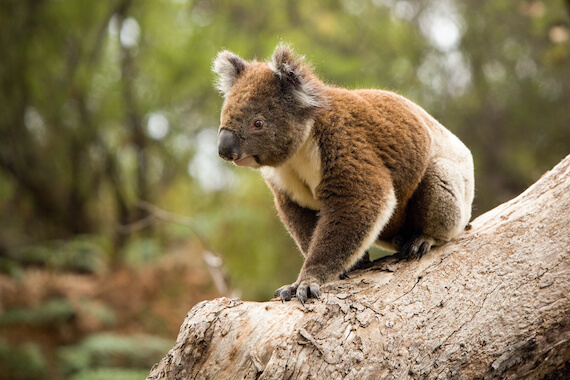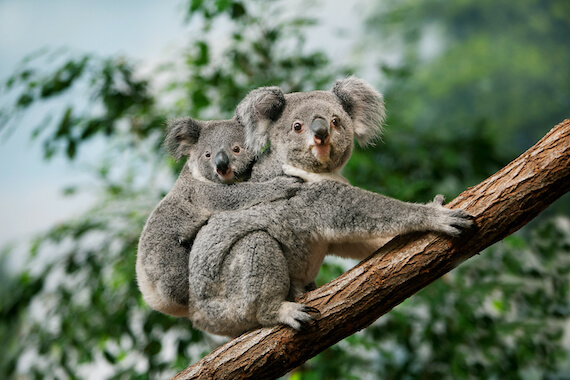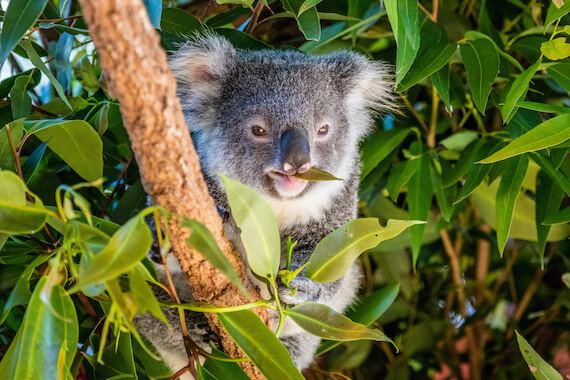
| Kingdom | Animalia |
| Phylum | Chordata |
| Class | Mammalia |
| Infraclass | Marsupialia |
| Order | Diprotodontia |
| Family | Phascolarctidae |
| Genus | Phascolarctos |
| Species | Phascolarctos cinereus |
| Niche | Herbivorous arboreal marsupial |
| Height | 24 – 33 inches (60 – 85 cm) |
| Weight | 9 – 33 lb (4 – 15 kg) |
| Lifespan | 13 – 18 years |
| Social Structure | Solitary |
| Conservation Status | Vulnerable |
| Preferred Habitat | Eucalyptus forests of southern and eastern Australia |
| Average Number of Offspring | 1 |
| Main Food Item | Leaves of eucalypt plants |
| Predators | Dingos, pythons, birds of prey |
The Basics
The koala is a single species of arboreal marsupial mammal native to the eucalyptus forests of southern and eastern Australia. Although these animals are often referred to as ‘koala bears’, they are only distantly related to the bear family and instead belong to the marsupial infraclass, 70% of which are found exclusively on the Australian continent.
The physical characteristics of koalas differ across their range, exhibiting a gradient from north to south. Populations in the north are smaller with grey fur, whilst those in the south are larger with thick brown fur. These differences are thought to result from adaptations of more southerly populations to colder climates and have prompted some scientists to suggest that two sub-species of koala should be recognized.

Ecology
Koalas are solitary animals and rarely share trees with other individuals. Male home ranges tend to be larger than those of females, although there is extensive overlap between the home ranges of both sexes. Male koalas have scent glands on their chests, which they use to mark trees within their home range by rubbing themselves against the branches. Males also communicate via loud, low-frequency bellows that can be heard over large distances. Males bellow most frequently during the mating season, perhaps to attract females or ward off other males. Additionally, males bellow when they enter a new tree in order to advertize their presence to others.
Koalas have a highly specialized diet, feeding mainly on the leaves of eucalyptus plants. Although hundreds of eucalyptus species exist, koalas show a strong preference for certain species and use their well-developed sense of smell to distinguish between them. Eucalyptus leaves have a very high water content, therefore koalas do not need to drink often. However, these leaves are also very nutrient-poor, meaning that koalas must eat up to a kilogram of leaves per day. Even so, koalas still don’t gain a lot of energy from their diet and are largely sedentary, sleeping for up to 20 hours per day.

Reproduction
As is the case for all marsupials, koalas give birth to under-developed live young that develop to maturity whilst being carried inside their mother’s pouch. Koalas are seasonal breeders and births occur between October and May each year. After a gestation period of only 33 – 35 days, females give birth to a single joey, although twins do sometimes occur. Joeys are still in the embryonic stage of development when born and weigh only 0.02 ounces (0.5 g).
Joeys are blind at birth, so use their senses of smell and touch to find their mother’s pouch. Here they attach to a teat and suckle milk for up to 7 months before they leave the pouch. Joeys first open their eyes around 13 weeks after birth and begin to poke their head out of the pouch around 26 weeks after birth. Once a joey emerges from its pouch at 7 months old, it continues to be transported on the back of its mother, but gradually gains more and more freedom until it is fully weaned at 12 months old. Mothers can be aggressive to newly weaned koalas in order to encourage them to disperse.

Fun Facts about Koalas
Koalas exhibit a number of adaptions that help them to survive in their native habitat and provide examples of several interesting biological concepts.
Finger prints
Koalas are the only other animal aside from humans and closely related primates such as gorillas, chimpanzees and orangutans to have finger prints that are unique to each individual. Given that primates and koalas aren’t closely related in evolutionary terms, finger prints must have evolved separately in these two groups. This is therefore an example of convergent evolution, whereby two groups exhibit similar traits despite these traits not being present in their last common ancestor.
It has previously been theorized that fingerprints might have evolved in both primates and koalas to provide grip by increasing friction between an individual’s hand and the surfaces they touch. However, recent research suggests that fingerprints might have instead evolved to increase tactile sensitivity by channelling vibrations to pressure sensors beneath the skin. This increased sensitivity could help individuals distinguish between good and bad food by allowing a fine-scale perception of texture.
Toxic diet
In addition to being extremely low in nutrients, the koala’s diet of eucalyptus leaves is also highly toxic. Yet along with another Australian marsupial, the greater glider, koalas have evolved adaptations that allow them to consume these leaves safely. As well as having a very slow digestive process, koalas produce the enzyme cytochrome P450, which breaks down the eucalyptus toxins in the liver.

But these aren’t the only animals that are able to digest toxic foods, as a wide array of herbivores have evolved to eat toxic plants. For example, both the moose and mule deer have adapted to a diet high in toxic tannins by producing a protein in their saliva that renders the tannins inactive. Furthermore, numerous insect species produce a protein that can convert toxic cyanide from their diet into another, harmless molecule.
Paw adaptations
Koala paws exhibit several adaptations that help them survive in their arboreal habitat. For example, both their front and hind paws have rough skin and long sharp claws, which provide grip when climbing trees. The front paws of koalas have five digits, two of which are opposable to the other three, like human thumbs. Therefore, this is another adaptation that helps koalas to grip onto trees.
The hind paws of koalas also have five digits, although only one of these is opposable and has no claw. The second and third digits are fused together, as is common for members of the order Diprotodontia. This adaptation, which is also thought to aid climbing, results in a single digit with two claws, which koalas and other species such as wombats and possums use for grooming.
